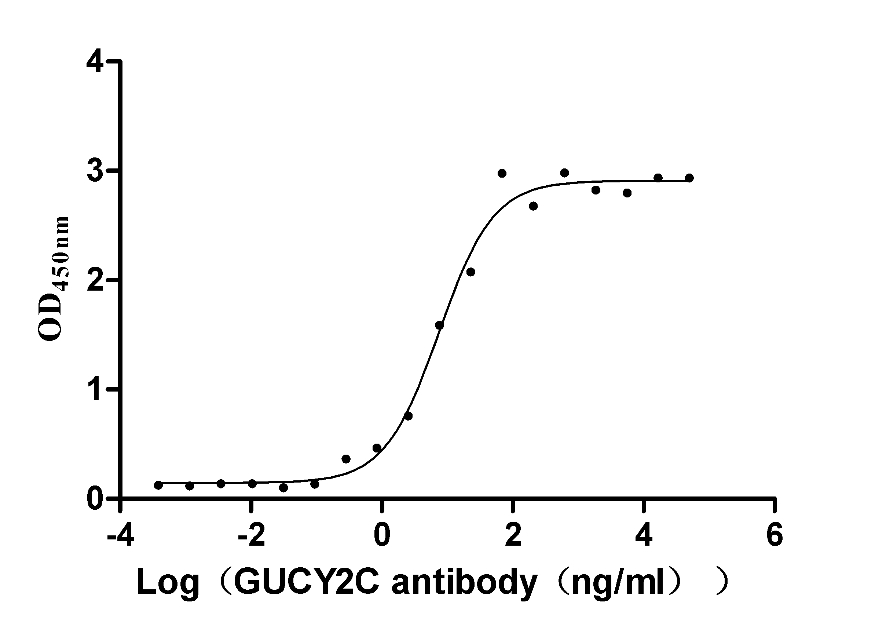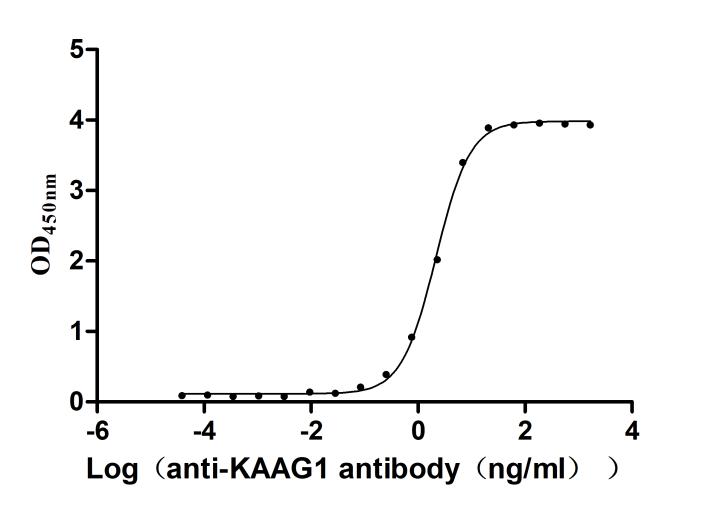Recombinant Mouse Potassium voltage-gated channel subfamily KQT member 1 (Kcnq1)
-
中文名称:小鼠Kcnq1重组蛋白
-
货号:CSB-CF012087MO
-
规格:
-
来源:in vitro E.coli expression system
-
其他:
产品详情
-
基因名:Kcnq1
-
Uniprot No.:
-
别名:Kcnq1; Kcna9; Kvlqt1; Potassium voltage-gated channel subfamily KQT member 1; IKs producing slow voltage-gated potassium channel subunit alpha KvLQT1; KQT-like 1; Voltage-gated potassium channel subunit Kv7.1
-
种属:Mus musculus (Mouse)
-
蛋白长度:Full length protein
-
表达区域:1-668
-
氨基酸序列MDTASSPPSAERKRAGWSRLLGARRGSAVVKKCPFSLELAEGGPEGSTVYAPIAPTGAPG LAPPMSTPVSPAPAPADLGPRPRVSLDPRVSIYSARRPLLARTHIQGRVYNFLERPTGWK CFVYHFTVFLIVLVCLIFSVLSTIEQYAALATGTLFWMEIVLVVFFGTEYVVRLWSAGCR SKYVGIWGRLRFARKPISIIDLIVVVASMVVLCVGSKGQVFATSAIRGIRFLQILRMLHV DRQGGTWRLLGSVVFIHRQELITTLYIGFLGLIFSSYFVYLAEKDAVNESGRIEFGSYAD ALWWGVVTVTTIGYGDKVPQTWVGKTIASCFSVFAISFFALPAGILGSGFALKVQQKQRQ KHFNRQIPAAASLIQTAWRCYAAENPDSATWKIYVRKPARSHTLLSPSPKPKKSVMVKKK KFKLDKDNGMSPGEKMFNVPHITYDPPEDRRPDHFSIDGYDSSVRKSPTLLEVSTPHFLR TNSFAEDLDLEGETLLTPITHVSQLRDHHRATIKVIRRMQYFVAKKKFQQARKPYDVRDV IEQYSQGHLNLMVRIKELQRRLDQSIGKPSLFIPISEKSKDRGSNTIGARLNRVEDKVTQ LDQRLVIITDMLHQLLSMQQGGPTCNSRSQVVASNEGGSINPELFLPSNSLPTYEQLTVP QTGPDEGS
Note: The complete sequence including tag sequence, target protein sequence and linker sequence could be provided upon request. -
蛋白标签:N-terminal 10xHis-tagged
-
产品提供形式:Liquid or Lyophilized powder
Note: We will preferentially ship the format that we have in stock, however, if you have any special requirement for the format, please remark your requirement when placing the order, we will prepare according to your demand. -
缓冲液:Lyophilized from Tris/PBS-based buffer, 6% Trehalose, pH 8.0
-
储存条件:Store at -20°C/-80°C upon receipt, aliquoting is necessary for mutiple use. Avoid repeated freeze-thaw cycles.
-
保质期:The shelf life is related to many factors, storage state, buffer ingredients, storage temperature and the stability of the protein itself.
Generally, the shelf life of liquid form is 6 months at -20°C/-80°C. The shelf life of lyophilized form is 12 months at -20°C/-80°C. -
货期:Basically, we can dispatch the products out in 1-3 working days after receiving your orders. Delivery time may differ from different purchasing way or location, please kindly consult your local distributors for specific delivery time.Note: All of our proteins are default shipped with normal blue ice packs, if you request to ship with dry ice, please communicate with us in advance and extra fees will be charged.
-
注意事项:Repeated freezing and thawing is not recommended. Store working aliquots at 4°C for up to one week.
-
Datasheet & COA:Please contact us to get it.
相关产品
靶点详情
-
功能:Potassium channel that plays an important role in a number of tissues, including heart, inner ear, stomach and colon. Associates with KCNE beta subunits that modulates current kinetics. Induces a voltage-dependent by rapidly activating and slowly deactivating potassium-selective outward current. Promotes also a delayed voltage activated potassium current showing outward rectification characteristic. During beta-adrenergic receptor stimulation participates in cardiac repolarization by associating with KCNE1 to form the I(Ks) cardiac potassium current that increases the amplitude and slows down the activation kinetics of outward potassium current I(Ks). Muscarinic agonist oxotremorine-M strongly suppresses KCNQ1/KCNE1 current. When associated with KCNE3, forms the potassium channel that is important for cyclic AMP-stimulated intestinal secretion of chloride ions. This interaction with KCNE3 is reduced by 17beta-estradiol, resulting in the reduction of currents. During conditions of increased substrate load, maintains the driving force for proximal tubular and intestinal sodium ions absorption, gastric acid secretion, and cAMP-induced jejunal chloride ions secretion. Allows the provision of potassium ions to the luminal membrane of the secretory canaliculus in the resting state as well as during stimulated acid secretion. When associated with KCNE2, forms an heterooligomer complex leading to currents with an apparently instantaneous activation, a rapid deactivation process and a linear current-voltage relationship and decreases the amplitude of the outward current. When associated with KCNE4, inhibits voltage-gated potassium channel activity. When associated with KCNE5, this complex only conducts current upon strong and continued depolarization. Also forms a heterotetramer with KCNQ5; has a voltage-gated potassium channel activity. Binds with phosphatidylinositol 4,5-bisphosphate.
-
基因功能参考文献:
- Our data indicate that mouse embryonic stem cells are induced into islet-like cells in vitro. The gene imprinting status of Kcnq1 and Cdkn1c may be changed in differentiated cells during the induction in vitro. PMID: 28926866
- Collectively, the s propose that Prmt1-dependent facilitation of KCNQ-phosphatidylinositol-4,5-bisphosphate interaction underlies the positive regulation of KCNQ activity by arginine methylation, which may serve as a key target for prevention of neuronal hyperexcitability and seizures. PMID: 27466704
- we investigated the effects of KCNQ1 A340E, a loss-of-function mutant. J343 mice bearing KCNQ1 A340E demonstrated a much higher 24-h intake of electrolytes (potassium, sodium, and chloride). KCNQ1, therefore, is suggested to play a central role in electrolyte metabolism. KCNQ1 A340E, with the loss-of-function phenotype, may dysregulate electrolyte homeostasis PMID: 27525866
- Loss of methylation at the Kcnq1 imprinted gDMD was strongly associated with trophoblast giant cell (TGC) expansion. PMID: 26241757
- Data show that disruption of potassium voltage-gated channel, KQT-like subfamily Q, member1 (KCNQ1) results in increased expression of cyclin-dependent kinase inhibitor 1C (Cdkn1c) only when the mutation is on the paternal allele. PMID: 26100882
- S3 mutations in KCNQ1 cause diverse kinetic defects in I(Ks), affecting opening and closing properties, and can account for LQT1 phenotypes. PMID: 25444851
- Characterization of the imprinted Kcnq1 domain which contains a differentially methylated region in intron 11 of Kcnq1. PMID: 25539921
- KCNQ1, KCNE2, and SMIT1 form reciprocally regulating complexes that affect neuronal excitability. PMID: 24595108
- low expression of KCNQ1 expression was significantly associated with poor overall survival. PMID: 23975432
- Which participates in the allelic repression of Kcnq1. PMID: 24395636
- H(+)-K(+)-ATPase/KCNQ1 reside in independent intracytoplasmic membrane compartments, or membrane domains, and upon activation of parietal cells, both membrane proteins are transported, possibly via Rab11-positive recycling endosomes, to apical membranes. PMID: 23154976
- our studies reveal regulatory mechanisms within the Kcnq1 imprinted domain that operate exclusively in the heart on Kcnq1 a gene crucial for heart development and function. PMID: 23028363
- Expression of KCNQ1 and NKCC1 protein in the stria vascularis of C57BL/6J mice decreases with age. PMID: 21426709
- We showed the disturbance of parietal cell differentiation and mucous neck-to-zymogenic cell lineage differentiation with enhanced expression of KCNQ1 in the parietal cells. PMID: 20437101
- Data show that in early pregnant mouse myometrium, the relative abundance of mRNA expression was KCNQ3 > KCNQ4 > KCNQ5 > KCNQ1 > KCNQ2. PMID: 20132415
- Kcnq1 is expressed in the cell membrane of thyroid follicular cells and plays a significant role in thyroid function. plasma concentrations of T3/T4 are lower in Kcnq1 knockout mice than in their wild-type littermates PMID: 20978783
- Repression of the paternal allele of several imprinted genes (including Kcnq1) on distal chromosome 7 is regulated by a non-coding antisense transcript, Kcnq1ot1, which is paternally expressed. PMID: 17021040
- KCNQ1 loss-of-function mutation impairs gastric acid secretion in mice. PMID: 19306073
- Data suggest that because the abundance and subcellular localization of KCNQ1 was unchanged in kcne3(-/-) mice, the modification of biophysical properties of KCNQ1 by KCNE3 is essential for its role in intestinal and tracheal transport. PMID: 20051516
- Loss of Igf2 imprinting in monoclonal mouse hepatic tumor cells is not associated with abnormal methylation patterns for the H19 and Igf2 differentially methylated regions. PMID: 12475990
- KCNQ1 and beta2-ARs associate and have a role in modulating the function of IKs channels under conditions of increased beta2-AR expression PMID: 15272004
- Kcnq1 mutant mice are a powerful new tool for investigating the connection between acid balance, Helicobacter infection and mucin disruption in the progression to gastric cancer. PMID: 15385447
- NF-Y transcription factor as a crucial regulator of antisense promoter-mediated bidirectional silencing and the parent of origin-specific epigenetic marks at the Kcnq1 imprinting control region PMID: 15459184
- Based upon previous studies and the present results, it is concluded that both hKCNE4 and mKCNE4 have a drastic inhibitory impact on both hKCNQ1 and mKCNQ1 currents. PMID: 15707997
- Kcnq1 knockout mice show histopathology comparable to that reported in human temporal bone cases of Jervell and Lange-Nielsen syndrome and provide further evidence that KCNQ1 channel dysfunction can lead to congenital deafness in this syndrome. PMID: 15891643
- luminal KCNQ1 serves to repolarize the proximal tubule and stabilize the driving force for Na+ reabsorption PMID: 16314573
- KCNQ1 has cell-specific roles in renal ion transport and may participate in K(+) secretion and/or absorption PMID: 16896189
- Murine blood vessels exhibit a distinctive expression profile of KCNQ1, KCNQ4, and KCNQ5, with 'neuronal' KCNQ4 dominating PMID: 17519950
- These results demonstrate for the first time that Kcnq1 protein is expressed in adult mouse hearts where it contributes to a beta-adrenergic-induced component of I(SS) that does not require co-assembly with Kcne1. PMID: 17597584
- The Kcnq1 mutation in vtg-2J mice alters various physiological functions in the cardiac, gastric and adrenocortical systems. PMID: 17660684
- We conclude that fenofibrate inhibits intestinal cAMP-stimulated Cl(-) secretion through a nongenomic mechanism that involves a selective inhibition of basolateral KCNQ1/KCNE3 channel complexes. PMID: 17916649
- These results suggest that although it is expressed in nearly all taste bud cells, the function of KCNQ1 is not required for gross taste bud development or peripheral taste transduction pathways. PMID: 19006182
- The mutation of KCNQ1 potassium channel did not affect the channel kinetics, whereas the surface expression increased with increasing hydrophobicity of the middle amino aicd residue. PMID: 19041715
- The effect of APC in the regulation of gastric acid secretion requires H+/K+ ATPase activity and is at least partially due to SGK1-dependent upregulation of KCNQ1. PMID: 19255508
- The observations indicate that KCNQ1 is a novel molecule affecting insulin sensitivity of glucose metabolism. PMID: 19369585
- A 166 kb region near the Kcnq1 transcriptionally imprinted domain showed high recombination activity. PMID: 19439080
- KCNQ1 channel provides K(+) to the extracellular K(+) binding site of the H(+)/K(+)-ATPase during acid secretion, and no other gastric K(+) channel can substitute for this function. PMID: 19491250
显示更多
收起更多
-
亚细胞定位:Cell membrane; Multi-pass membrane protein. Cytoplasmic vesicle membrane. Early endosome. Membrane raft. Endoplasmic reticulum. Basolateral cell membrane.
-
蛋白家族:Potassium channel family, KQT (TC 1.A.1.15) subfamily, Kv7.1/KCNQ1 sub-subfamily
-
组织特异性:Expressed in heart, kidney and salivary glands. Detected in the cochlea. Almost undetectable in brain, skeletal muscle and liver. Widely expressed in embryonic and neonatal tissues.
-
数据库链接:
KEGG: mmu:16535
STRING: 10090.ENSMUSP00000009689
UniGene: Mm.439769
Most popular with customers
-
Recombinant Human Heat-stable enterotoxin receptor (GUCY2C), partial (Active)
Express system: Mammalian cell
Species: Homo sapiens (Human)
-
Recombinant Human Tumor necrosis factor ligand superfamily member 9 (TNFSF9), partial (Active)
Express system: Mammalian cell
Species: Homo sapiens (Human)
-
Recombinant Rat Intestinal-type alkaline phosphatase 1 (Alpi) (Active)
Express system: Mammalian cell
Species: Rattus norvegicus (Rat)
-
Recombinant Human Complement component C1q receptor (CD93), partial (Active)
Express system: Mammalian cell
Species: Homo sapiens (Human)
-
Recombinant Human Myosin regulatory light polypeptide 9 (MYL9) (Active)
Express system: Yeast
Species: Homo sapiens (Human)
-
Recombinant Human Kidney-associated antigen 1(KAAG1) (Active)
Express system: E.coli
Species: Homo sapiens (Human)
-
Express system: Mammalian cell
Species: Homo sapiens (Human)



















